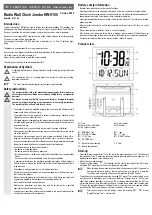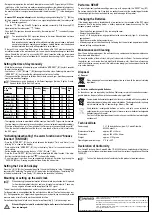
• During normal operation, the wall clock attempts to receive the DCF signal daily at 03.00 am
(night) since at this time there are optimum reception conditions (low external interferences).
The wall clock performs another reception attempt at 04.00 am, 05.00 am and 06.00 am. In
the event of a failure (= no signal reception possible) the radio symbol “
” in the display goes
out.
• A manual DCF reception attempt can be started by pressing and holding the “
” (B6) key
for three seconds. In the event of a failure (= no signal reception possible) the radio symbol
“
” in the display goes out.
Press the “
” (B6) key if the DCF signal was received successfully. With incoming DCF
signal reception the radio symbol “
” flashes.
Once the DCF signal was received successfully, the radio symbol “
” is constantly shown
in the display.
☞
The reception of the DCF signal can take up to 5 minutes. Meanwhile do not move
the wall clock. Do not use any buttons.
Bad reception can be expected with metallised insulating glass windows, reinforced
concrete constructions, coated special wallpaper, heating devices, electric/electronic
devices located in the vicinity of the product or in cellar rooms.
• If there still is no current Time/Date shown in the display after 10-20 minutes change the
installation location of the wall clock and start a new manual reception attempt as described
above. Should this not result in a successful DCF signal reception either, we recommend
placing the wall clock in front of a window for 24 hours and then checking if a DCF signal was
received.
Setting the time of day manually
• While the time is shown in the display, press and hold the “MODE/SET” (B1) key for 3 seconds
to enter the time setting.
• Use the keys “+12/24” (B3) and “-” (B5) to change the setting value. Following that, press the
“MODE/SET” (B1) key to confirm the setting and to enter the next setting.
• The sequence of the settings is as follows: Hour, minute, second, year, month/day sequence,
month, day, weekday language.
☞
The weekday may be displayed in 8 different languages (German, English, French,
Spanish, Italian, Dutch, Danish, Russian).
Day of the
Sunday
Monday
Tuesday Wednes- Thursday Friday Satur-
week
day
day
language
German, GER
SO
MO
DI
MI
DO
FR
SA
English, ENG
SU
MO
TU
WE
TH
FR
SA
Russian, RU
BC
NH
BT
CP
HT
NT
CY
Danish, DAN
SO
MA
TI
ON
TO
FR
LO
Dutch, NET
ZO
MA
DI
WO
DO
VR
ZA
Italian, ITA
DO
LU
MA
ME
GI
VE
SA
Spanish, ESP
DO
LU
MA
MI
JU
VI
SA
French, FRA
DI
LU
MA
ME
JE
VE
SA
• The language is chosen in accordance with the country where the DCF signal can be received.
The time zones vary from country to country and thus, a correct selection is required accordingly.
• If the time of the country e.g. is 1 hour ahead of the German time, the zone should be set to 1.
Thus, the clock will automatically set the time to 1 hour ahead of the time that is received by
the DCF signal.
“Activating/deactivating” the alarm function and “Snooze
function” (SNOOZE)
• Press the “MODE/SET” (B1) key to select between the displays “Time” and “Alarm” (= the
lettering “AL” is shown in the display).
• Press and hold the “MODE/SET” (B1) key in the display “Alarm” for 3 seconds to enter the
alarm setting.
• Set the desired alarm time using the keys “+12/24” (B3) and “-” (B5).
• Press the “Alarm ON/OFF” (B2) key to activate or deactivate the alarm function. If the alarm
function is activated the alarm symbol “
” is shown in the display.
• If an alarm signal is emitted it can be suppressed for approx. 5 minutes by pressing the
“SNOOZE” (B4) key. Pressing any other button will stop the active alarm.
Setting the 12 or 24h display
Press the “+12/24” (B3) key to swap between the 12h and the 24h display. In the 12h display the
characters “AM” before the “Time display” (A1) indicate the first half of the day. The lettering “PM”
in the display before the “Time Display” (A1) indicates the second half of the day.
Mounting or setting up the wall clock
☞
When selecting the operation location of the wall clock pay attention that it is placed
far from electric/electronic devices, cables, wall sockets or metal parts. These may
have a negative influence on the reception of the DCF signal.
This wall clock can either be placed on a stable surface or mounted on a vertical wall.
For the operation in an upright position the wall clock has a fold-out “foot” on the housing’s rear
(C3). During operation in an upright standing position you may want to use an underlay to avoid
pressure marks or small scratch marks on valuable furniture.
For wall mounting the wall clock has a “device for wall mounting” (C1) at the housing’s rear.
Ꮨ
When drilling holes in walls or when bolting to walls, ensure that no cables or
lines are damaged.
Perform a RESET
To reset all previously performed settings, press (e.g. with a paper clip) the “RESET” key (B7).
Do not use a pencil or the like. Since lead is a conductive material, the conducting paths inside
the housing might be short-circuited which may lead to damage of the product.
Changing the Batteries
If the display segments are displayed with a low contrast or the reception of the DCF signal
decreases due to low battery power, a battery replacement becomes necessary. For this
purpose, proceed as follows:
• Open the battery compartment (C2) by removing the cover.
• Remove the used batteries.
• Insert 3 x 1.5V baby batteries, paying attention to the correct polarity (type: C) in the battery
compartment.
• Place the cover on the battery compartment.
• All display segments will be shown shortly. Following that, the wall clock is operational and the
desired settings can be performed.
Maintenance and Cleaning
Apart from a battery replacement, this wall clock has no components that require maintenance.
Never dismantle the product.
To clean the outside of the wall clock, a dry, soft, clean cloth is sufficient. For heavier soiling of
the exterior, you can moisten the cloth slightly with lukewarm water. Clean the wall clock very
carefully, otherwise you may scratch it. Do not press too strongly on the transparent front as this
may cause breakage.
Disposal
a) General
When disposing of an unserviceable product, do so in line with the relevant statutory
regulations.
b) Batteries and Rechargeable Batteries
As the end user, you are required by law (Battery Ordinance) to return all used batteries/rechar-
geable batteries; disposal of them in the household waste is prohibited!
Contaminated batteries/rechargeable batteries are labelled with these symbols to
indicate that disposal in domestic waste is forbidden. The designations for the heavy
metals involved are: Cd = Cadmium, Hg = Mercury, Pb = Lead.
Used batteries, rechargeable batteries as well as coin cells can be returned to
collection points in your municipality, our stores or wherever batteries/rechargeable
batteries/coin cells are sold!
You thus fulfil the legal requirements and make your contribution to protecting the
environment!
Technical Data
Power supply:
3 x 1.5V baby batteries (type: C); Conrad Order No.:
652544, order 3 x
Dimensions of display:
approx. 387 x 334 mm
Dimensions:
approx. 490 x 396 x 46 mm
Weight:
approx. 2,100 grams
Operating temperature range:
0°C to +45°C
Declaration of Conformity
We, Conrad Electronic, Klaus-Conrad-Strafle 1, D-92240 Hirschau, hereby declare that this pro-
duct conforms to the fundamental requirements and the other relevant regulations of Directive
1999/5/EC.
☞
You can find the declaration of conformity for this product at www.conrad.com.
These operating instructions are a publication by Conrad Electronic SE, Klaus-Conrad-Str. 1, D-92240
Hirschau (www.conrad.com).
All rights including translation reserved. Reproduction by any method, e.g. photocopy, microfilming, or
the capture in electronic data processing systems require the prior written approval by the editor.
Reprinting, also in part, is prohibited.
These operating instructions represent the technical status at the time of printing. Changes in
technology and equipment reserved.
© Copyright 2010 by Conrad Electronic SE.


























